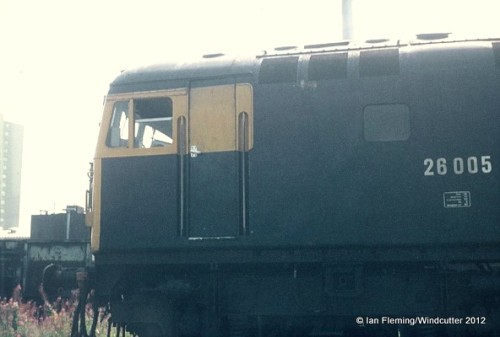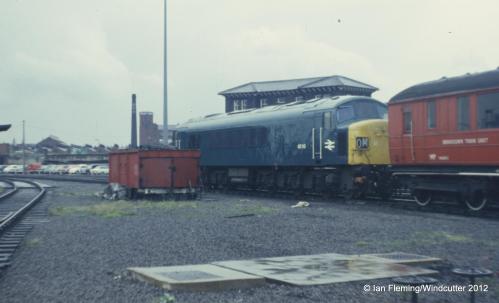Oh yes; the end of steam, what happened during its last few years and afterwards. Quite a misunderstood interlude, if recurrent questions around the forums are anything to go by. The aspect on which I’ve most recently seen an unusual amount of hot air expended is that of five-figure computerised numbering (usually known as ‘TOPS numbers’); though whether they were strictly necessary for TOPS to function isn’t something I’m going to get into here – as far as the modeller or enthusiast is concerned, it’s their effect on the appearance of the loco that matters.
The class numbers were initially allocated as far back as 1968, although as is often the way with these things, many types were withdrawn before carrying the five-figure numbering. The first loco to actually carry the new style was an EM1 electric, 26050, which was renumbered 76050 in November 1971. A few more 76s followed during 1972, along with AC electrics of classes 83 and 84 which, after a period in store, were undergoing work to augment the fleet for the extension of 25kV wires to Glasgow.
Diesel renumbering didn’t start until 1973, initially with class 45 ‘Peaks’; the first was 45101 in March 1973, which had undergone conversion for ETH (electric train heating). The wholesale renumbering of the rest of the fleet started from the autumn of that year, and was initially quite slow as locos were generally only done on works visits. By early 1974, ‘crash’ renumbering programmes had been instituted at depots and the bulk of renumbering work had been completed by that summer. No longer did the new numbers only sit on shiny new paint, but were applied to scruffy blue and scruffy green alike – over 500 locos ran with TOPS numbering whilst still in green, with the last still being around in 1980.
Old Oak’s 31416 (ex-5842) was notable in being one of the first (if not the first) loco to be renumbered without a works visit. It’s seen here at Royal Oak on 29.9.73, on its usual Paddington carriage pilot duties.
Below, a recipient of an ER depot renumbering (in this case quite neatly done), 20133 (ex-8133) is seen at Barrow Hill on 5.7.75. It also shows three distinct styles of allocation sticker.
As ever, records do present anomalies, notably in that several Scottish Region locos (including 27s and 37s) don’t seem to have been renumbered until as late as autumn 1974, but it’s generally thought that this was just a question of late record keeping with the actual locos having been done some months earlier. The ScR also gave us some interesting variations, such as numbers on secondman’s side cabs on locos with tablet catcher recesses, and a handful of locos like the one below.
26005 (ex-5305) at Glasgow Works on 10.8.75 has its new number applied with old transfers in the serif style used on green locos. This is the only 26 known, although there were several 27s (including some push-pull ones with the ’27’ in one style and the rest in the other), and a sole 25, 25217.
There were some bona fide exceptions to the 1974 cutoff though, being members of classes 45 and 47 which had been identified for conversion to ETH but rather than carrying numbers in the 45/0 or 47/0 series, kept their four digit numbers until called to works. Some of these stragglers ran with the old numbers well into 1975, and as is fairly well known, WR hydraulics of classes 35 and 52 also remained untouched due to being slated for early withdrawal and the difficulty in removing their cast numbers.
As mentioned in the text, renumbering of class 45 started slightly before other diesels. One peculiarity of this was that the first ones done had numbers on all four corners, as seen here with 45110 (ex- 73) at Holbeck on 7.8.73. By the time renumbering had started on other diesels, the familiar pattern of numbers on driver’s side only had been established.
Sources
The Allocation History of BR Diesels and Electrics, self-published by Roger Harris. My copy is the original 1986 edition but the work has more recently been reissued in expanded form.
Green TOPS – The Definitive List
Livery guru Russell Saxton’s diligently researched findings originally appeared in Rail Express Aug 2003 and now appear on the Rail Blue website:
http://www.railblue.com/rail_blue_history_2.htm
Russ also has a Flickr group on the same theme, which is at:
http://www.flickr.com/groups/br_green_liveried_tops_locos/pool/with/4574395547/#photo_4574395547





Hi Ian,
Am I correct in thinking that Class 45s (and possibly Class 46s) were initially renumbered without reference to the numbers that they carried pre-TOPS. I seem to remember that it was in order that they were called to works. Were these the only classes that were renumbered in such a fashion?
David
Hi David
As noted above, 45s and 47s were both subject to ETH conversion programmes; I think at some point the locos were positively earmarked, probably based on ‘due shops’ dates.
44s and 46s were all renumbered sequentially, although they illustrate the two basic differences in treatment. Because the former were originally 1 to 10, it was logical that they became 44001 -10, but as the 46s started at 138, they were still done in sequence but the last digits couldn’t correlate. Other less logical examples were due to gaps in the pre-TOPS numbering – for instance 08s (due to withdrawals and to there having been ‘non-08’ derivatives in the sequence) and 31s, which again had gaps due to ETH fitted locos being put into another sequence.